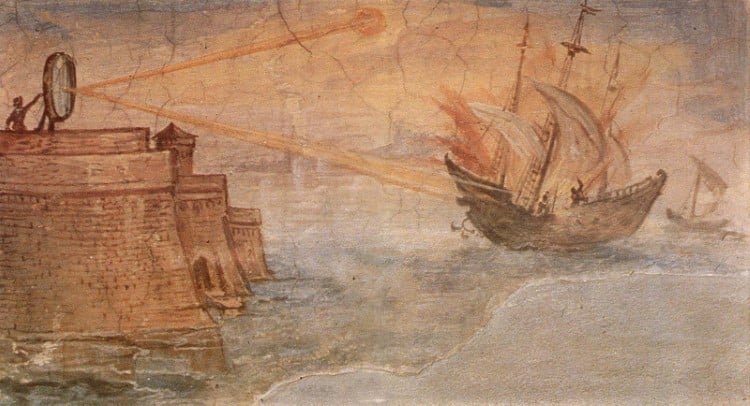
Artist rendering of Archimedes' Death Ray by Giulio Parigi, c. 1600. Uffizi Gallery, Stanzino delle Matematiche. (Photo: Wikimedia Commons, Public domain)
A middle school student from Ontario has just proven that the mythical heat ray by Greek mathematician Archimedes could be real. Purported to have been used to burn Roman ships during the 3rd century BCE Siege of Syracuse, this invention used mirrors and the sun to defeat the enemy.
Archimedes' death ray was first mentioned in the 2nd century CE by the author Lucian, who said that Archimedes burned enemy ships. Eventually, it was clarified that he did so using the sun's rays. It is believed that he angled several different mirrors in order to bring the sun together at one point. The extreme heat then caused the ships to quickly go up in flames.
When tasked with selecting a project for the science fair, 12-year-old Brenden Sener decided to see if this ancient death ray was just a myth or if it could actually work. To do so, he created a miniature version of the apparatus. His setup included several simple items he was able to order on Amazon, including concave mirrors, two different heating lamps, an infrared thermometer, and a piece of cardboard.

Photo: Brenden Sener
After marking his focal point on the cardboard, Sener used the thermometer to measure the temperature at the target as he increased the number of mirrors and varied the wattage of the heat lamp. The results clearly show how the mirrors amplified the heat. Using a 100W LED heat lamp, the temperature moved from 27°C (80.5°F) when just the lamp was on to a scorching 54°C (129.2°F) when four mirrors were used.
In his report, Sener acknowledges that others have tried to prove the veracity of Archimedes' heat ray. Most famously, Mythbusters took a crack at recreating the experiment. While they showed that temperature increased, they weren't able to cause flames. But the pre-teen reminds us that in Mythbusters, multiple mirrors were used on a single stand. Sener's use of several mirrors in different positions more realistically reflects the ancient depictions, which show mirrors scattered across the Bay of Syracuse.
While Sener didn't have a way to test his findings on a real boat, his work is backed up by other experiments. In 2005, a group from MIT found that Archimedes' death ray could set a ship aflame in just 11 minutes.
For his efforts, Sener was awarded handsomely. He took home the Matthews Hall Annual Science Fair Gold Medal, the Physical Sciences Thames Valley Science and Engineering Fair Gold Medal, and the London Public Library Award for Inspiring Children’s Interests in Science and Technology.
h/t: [IFL Science!]
Related Articles:
17-Year-Old Designs a Motor That Could Change How Electric Cars Are Made
High School Science Teacher Explains Bernoulli’s Principle in Viral TikTok Video
12-Year-Old Invents Affordable Fire Detection System That Sends Alerts to Your Phone
17-Year-Old Invents Low-Cost Machine Learning Software That Can Detect Elephant Poachers






















































































